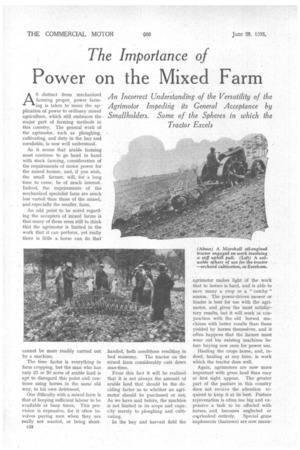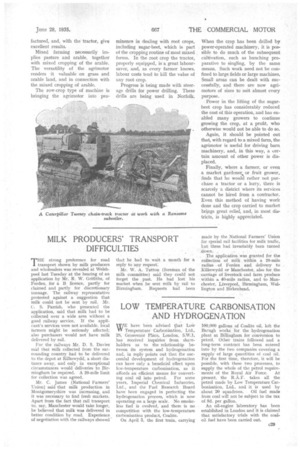The Importance of
Page 78

Page 79

If you've noticed an error in this article please click here to report it so we can fix it.
Power on the Mixed Farm
An Incorrect Understanding of the Versatility of the Agrimotor Impeding its General Acceptance by Smallholders. Some of the Spheres in which the Tractor Excels
AS distinct from mechanized farming proper, power farming is taken to mean the application of power to ordinary mixed agriculture, which still embraces the major part of farming methods in this country. The general work of the agrimotor, such as ploughing, cultivating, and duty in the hay and cornfields, is now well understood.
As it seems that arable farming must continue to go hand in hand with stock farming, consideration of the requirements of motor power for the mixed farmer, and, if you wish, the small farmer, will, for a long time to come, be of much interest. Indeed, the requirements of the mechanized specialist farm are much less varied than those of the mixed, and especially the smaller, farm.
An odd point to be noted regarding the occupiers of Mixed farms is that many of them seem still to think that the agrimotor is limited in the work that it can perform, yet really there is little a horse can do that cannot be more readily carried out by a machine.
The time factor is everything in farm cropping, but the man who has only 25 or 30 acres of arable land is apt to disregard this point and continue using horses in the same old way, to his own detriment.
One difficulty with a mixed farm is that of keeping sufficient labour to he available at busy times. This provision is expensive, for it often involves paying men when they are really not wanted, or being short
c28 handed, both conditions resulting in bad economy. The tractor on the mixed farm considerably cuts down man-time.
From this fact it will be realized that it is not always the amount of arable land that should be the deciding factor as to whether an agrimotor should be purchased or not. As we have said before, the machine is not limited in its scope and capacity merely to ploughing and cultivating.
In the hay and harvest field the agrimotor makes light of the work that to horses is hard, and is able to save many a crop in a " catchy " season. The power-driven mower or binder is best for use with the agrimotor, and gives the 'most satisfactory results, but it will work in conjunction with the old horsed machines with better results than those yielded by horses themselves, and it often happens that the farmer must wear out his existing machines betore buying new ones for power use.
Hauling the crops home, and, indeed, hauling at any time, is work which the tractor does well.
Again, agrirnotors are now more important with grass land than may at first sight appear. The greater part of the pasture in this country does not receive the attention required to keep it at its best. Pasture rejuvenation is often too big and expensive a task to be effected with horses, and becomes neglected or owTlooked entirely. Special grass implements (harrows) are now manu factured, and, with the tractor, give excellent results.
Mixed farming necessarily implies pasture and arable, together with mixed cropping of the arable. The versatility of the agrimotor renders it valuable on grass and arable land, and in connection with the mixed cropping of amble.
The row-crop type of machine is bringing the agrimotor into pro
nainence in dealing with root crops, including sugar-beet, which is part of the cropping routine of most mixed farms. In the root crop the tractor, properly equipped, is a great laboursaver, and, as every farmer knows, labour costs tend to kill the value of any root crop.
Progress is being made with steerage drills for power drilling. These drills are being used in Norfolk. When the crop has been drilled by power-operated machinery, it is possible to do much of the subsequent cultivation, such as bunching preparative to singling, by the same means. Such work need not be confined to large fields or large machines. Small areas can be dealt with successfully, and there are now agrimotors of sizes to suit almost every purpose.
Power in the lifting of the sugarbeet crop has considerably reduced the cost of this operation, and has enabled many growers to continue growing the crop, at a profit, who otherwise would not be able to do so.
Again, it should be pointed out that, with regard to a mixed farm, the agrimotor is useful for driving barn. machinery, and, in this way, a certain amount of other, power is displaced.
Finally, where a farmer, or even a market garderier„,, or fruit grower, finds that he would rather not purchase a tractor or a lorry, there is scarcely a district where its services cannot be hired from a contractor. Even this method of having work done and the crop carried to market brings great relief, and, in most districts, is highly appreciated.




























































































































































